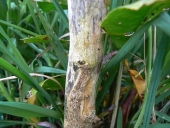posted 4 years ago
That is a nasty looking scar on the bark of that ash, and it is really close to the property. It's not a question of if it will come down, but when. I'm not going to hazard any guesses on a tree that I can't inspect in person, but it sounds like you are on track getting professionals to assess it. Be aware though that not all who work with trees are qualified to assess for safety, and some are too ready to condemn trees as dangerous to drum up work. We have a trusted tree surgeon we work with who does delicate reductions for us on ancient trees that are in decline.
It isn't at all clear from your photos, but is that ash suffering from ash dieback disease? If so then it will need to come down at some point. We have over a dozen ash trees that are limping along with it. We have no hopes for them recovering, but are not in a hurry to take them down either. The tree surgeons around here have a lot of experience working with them, and hate climbing them. Dieback weakens the heartwood and they are prone to shattering when under load. It is safer and generally cheaper to take them down before they get to that stage.
One option is what might be termed a "managed decline", often used on noteworthy ancient trees in the landscape. They have the crown reduced - sometime gradually over a number of years, some times drastically depending on conditions - and the the main trunk is left with a much smaller crown to maintain. This can drastically prolong the life of these trees, and as the trunk declines provides excellent habitat. I'm not sure either ash or sycamore would be good candidates for this, as they don't look particularly note worthy to start with.
Moderator, Treatment Free Beekeepers group on Facebook.
https://www.facebook.com/groups/treatmentfreebeekeepers/







